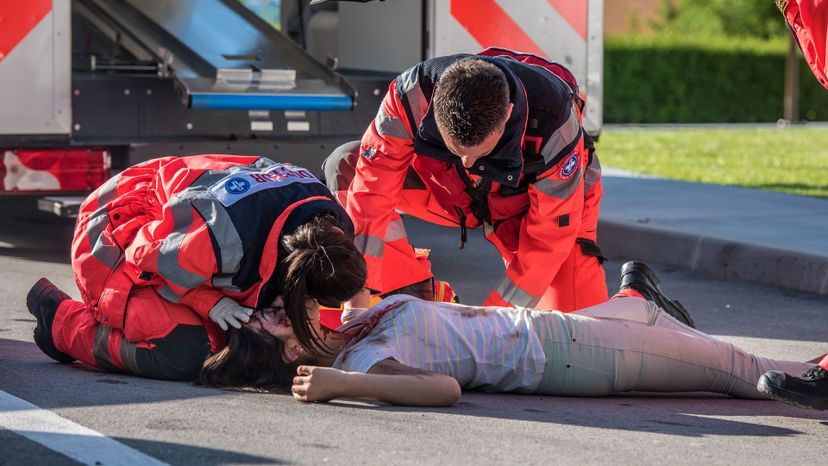
About This Quiz
Have you ever wondered what it takes to become a paramedic? You need to be trained and read to give emergency medical care to patients who are seriously ill and to stabilize them before they reach a hospital. Basically, you are responsible for the life of a human being. A paramedic’s goal is to assist and aid a person who is in serious need of medical attention.
As a paramedic, you will care for the sick or injured in emergency medical settings. The life of the patient the paramedic is attending to depends on the quick reaction and competent care provided by these individuals. You will also be responsible for responding to emergency calls, performing medical services and transporting patients to medical facilities for further help. But before you do any of this, you need to be prepared. Becoming a paramedic typically involves completing a postsecondary educational program. In all 50 states, paramedics must be licensed. Keep in mind that requirements vary by state, so you may need further licenses or training. You will be educated on physiology, cardiology, pharmacology and respiratory interventions, to name a few. Do you think you know as much as a paramedic? Take a moment to complete this quiz and find out!
ECG stands for electrocardiogram. Sometimes it’s also abbreviated as EKG. A doctor might suggest you get an electrocardiogram to check for signs of heart disease.
For this case, you’ll use the jaw thrust maneuver technique. If there is a possible spinal injury, you might want to open the jaw without moving the head too much.
You would identify any possible threats first. We all want to help someone in need right away, but in order to do so, you need to be safe (and alive).
Advertisement
You would cover the impacted area with moist, sterile dressing. It’s likely that the area is open and therefore susceptible to infection.
The paramedic is referring to acute coronary syndrome. This is a syndrome caused by decreased blood flow in the coronary arteries, affecting heart function.
You would abbreviate "milligram" as “mg.” 1 mg is equal to 1/1,000 of a gram.
Advertisement
You would abbreviate it as LUQ. You can always write out the words, but keeping things simple is usually better (and easier).
You would say the patient has a blocked NPA.
Though important, nutritional wellbeing is not considered a dimension of wellness. Emotional, mental and physical are all component of your wellness.
Advertisement
When using an esophageal detector device, the detection bulb should inflate to indicate that you are in the patient's trachea.
A keloid is a growth of excessive scar tissue over the site of a healed wound. Any injury that can cause a scar could result in the formation of a keloid.
No, it’s not a knockout. In paramedic terms, KO stands for “keep open."
Advertisement
Abbreviations should always be kept simple. Therefore, a paramedic will write down “DNR."
RP. That simple!
When writing weight on a report, you would abbreviate it as “wt.” Nothing too fancy.
Advertisement
“Temp.” is an abbreviation paramedics use for temperature. It comes in handy when writing long reports.
Hypovolemic shock occurs when a person loses at least 20 percent of the blood or fluids in their body. This requires immediate assistance.
Choanal atresia is a condition in which a child is born with one or both nostrils blocked by bony tissue. If both nostrils are blocked, the baby may be unable to breath right after birth and may need to be resuscitated.
Advertisement
The red lead on a standard system is also known as the left leg. The red lead should be facing the inferior surface of the heart.
Norepinephrine is helpful in that it can get the blood pressure up when treating a hypotensive patient. Therefore, you should expect all of the above reactions except a decrease in the heart’s workload.
The oropharynx is part of the upper airway. This is the posterior part of the mouth, making it the only part listed above that forms part of the upper airway.
Advertisement
The sitting position and drooling give it away. These are all signs of laryngitis.
A contraindication is a condition or situation that would make it unsafe to give a patient a certain treatment. In other words, it’s enough reason to not administer the medication.
The rectum is not considered to be a traditional parenteral route of medication administration. Rectal administration is considered to be an enteral route, because the rectum belongs to the digestive tract.
Advertisement
This is a major risk because a piece of the catheter can get stuck and block an artery.
The blood will flow into the left atrium. There are no ventricles involved.
When myocytes depolarize, this means the potential gets closer to 0 mV. During myocardial contraction, the cell potential is overall more positive.
Advertisement
If you can’t aspirate blood or bone marrow after a sudden decrease in resistance, this might not necessarily have anything to do with a needle misplacement; it's possible the needle. Therefore, you should flush the needle with saline and observe for infiltrate, or a buildup of foreign substance.
There is no pulse. Therefore, there is nothing to pace. Use other measures to help the patient.
The primary job of the mitochondria is to produce large amounts of energy to power the cell. This energy is created from oxygen and nutrients.
Advertisement